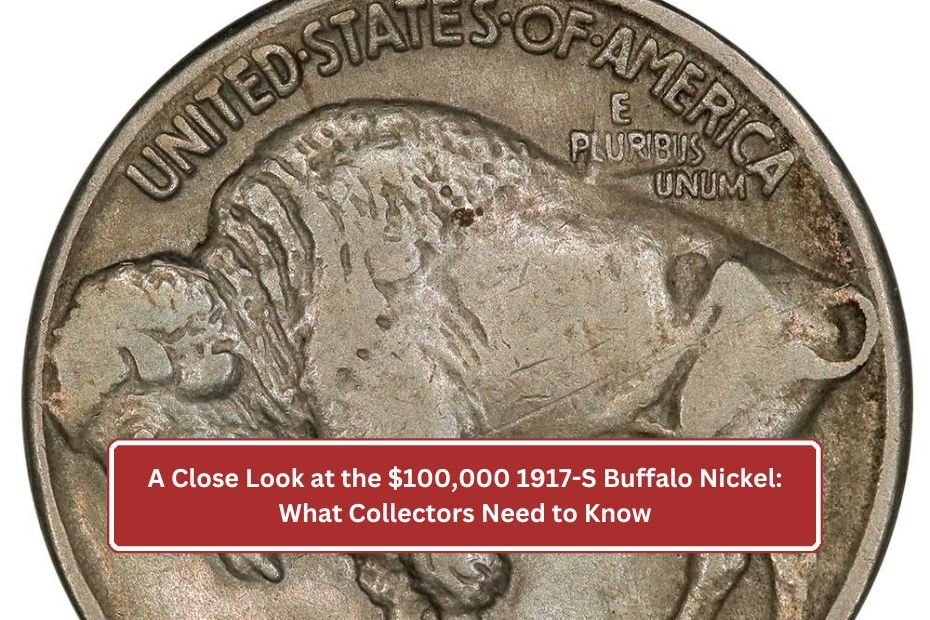Have you ever wondered if the coins in your pocket might be worth a fortune? A rare 1917-S Buffalo nickel recently sold for an incredible $100,000! This article will explain why this coin is so valuable and what details to look for in your own coins. Buffalo nickels are not just ordinary coins; they are pieces of history, each telling a story of its time. Let’s dive into the fascinating world of coin collecting and discover the secrets that can turn an everyday nickel into a treasure!
What Makes the 1917-S Buffalo Nickel So Valuable?
The 1917-S Buffalo nickel is special because of one important detail on its surface. This nickel has very clear and sharp engravings, which are not common in most nickels. Most coins of this type often have “weak” strikes, meaning the details are not as clear. This specific nickel was graded as MS-67, which is one of the highest ratings a coin can receive from the Professional Coin Grading Services (PCGS).
Did you know? Only a handful of nickels have received such a high grade, making this coin not just valuable, but exceptionally rare.
Key Details About the 1917-S Buffalo Nickel
| Feature | Details |
|---|---|
| Year | 1917 |
| Mint Mark | San Francisco (S) |
| Design | Native American on one side, buffalo on the other |
| Auction Price | $100,000 (sold on August 20, 2023) |
| Grade | MS-67 (highest grading) |
| Mintage | Over 4 million |
| Composition | 75% copper, 25% nickel |
| Unique Features | Sharp engravings, full design details |
The Design of the Buffalo Nickel
The Buffalo nickel features a striking image of a Native American on one side and a majestic buffalo on the other. Designed by sculptor James Earle Fraser, this coin was part of a movement in the early 1900s to improve American coin designs. What makes this coin particularly interesting is the story behind its creation. Fraser was inspired by the native peoples he encountered in his travels, and he wanted to create a coin that reflected America’s heritage and pride.
These coins were made from 1913 to 1938, and many were minted in different locations, including Philadelphia, Denver, and San Francisco. Interestingly, the buffalo depicted on the coin was modeled after Black Diamond, a famous bison that lived in New York’s Central Park Zoo.
How Rare Is This Coin?
In 1917, just over 4 million Buffalo nickels were minted in San Francisco. However, most of them do not survive in great condition. According to PCGS, the majority of these coins are graded at MS-65 or lower, making the MS-67 coin extremely rare. This rarity is what contributes to the high price at which it sold at auction.
Fun Fact: Coins that are well-preserved often tell the story of the time they were in circulation. Some collectors enjoy tracing the history of their coins, including where they might have traveled and how they were used.
Auction Results
On August 20, 2023, the 1917-S Buffalo nickel was sold for an impressive $100,000. It is notable that this nickel had full design details, including a bold hair braid on the front and a clearly defined tail on the buffalo side. The word “Liberty” is also clearly separated from the border, adding to its distinct features.
Coin Features That Increase Value
Several factors contribute to a coin’s value, including:
- Mintage: The fewer coins produced, the rarer they are.
- Design Variations: Coins with mistakes during minting can be worth more. This includes errors like double strikes, which create unique designs.
- Historical Significance: Coins that are tied to important events or figures can have higher values. For example, coins that commemorate historical milestones often attract collectors.
- Region: Where a coin was made can affect its rarity. Coins minted in smaller facilities are often rarer than those made in larger mints.
- Age: Older coins can be rarer, especially if they were not well-preserved. Some coins can reveal much about the history of currency in the United States.
- Supply and Demand: The more people want a coin, the more it can be worth.
What’s Inside the Buffalo Nickel?
The 1917-S Buffalo nickel is made of 75% copper and 25% nickel. Its surfaces display a bright and shiny gray luster with hints of gold and pale blue tones. These details make the coin even more attractive to collectors.
Other Rare Coins
Aside from the 1917-S Buffalo nickel, other rare coins can be worth thousands of dollars. For example, a TikTok user revealed a nickel from 1816 with a doubling feature that could make it worth $300,000. This doubling is caused by a mistake during the minting process where the design is stamped multiple times, creating a blurred effect.
Conclusion
Collecting coins can be an exciting and rewarding hobby, especially if you know what to look for. The 1917-S Buffalo nickel serves as an example of how specific details can dramatically increase a coin’s value. If you have old coins at home, it’s worth checking to see if they have unique features or are from notable years. You never know—you might find a hidden treasure worth thousands of dollars! Whether you’re a serious collector or just curious about coins, learning about their history and rarity can open a whole new world of possibilities.
FAQ’s
What makes the 1917-S Buffalo nickel worth $100,000?
The 1917-S Buffalo nickel is valued at $100,000 due to its exceptional condition, with sharp engravings and full design details. It is one of the highest-graded coins of its kind, making it extremely rare among collectors.
How can I tell if my nickel is valuable?
To determine if your nickel is valuable, check for unique features like sharp details, errors in minting (such as double strikes), and the coin’s date. Coins with a lower mintage and higher grade from professional grading services are generally worth more.
Where can I sell a rare coin like the 1917-S Buffalo nickel?
You can sell rare coins at auctions, through reputable coin dealers, or online platforms that specialize in numismatics. It’s a good idea to have your coin graded by a professional service like PCGS to establish its value before selling.

